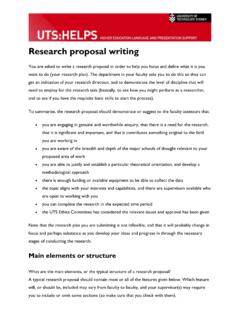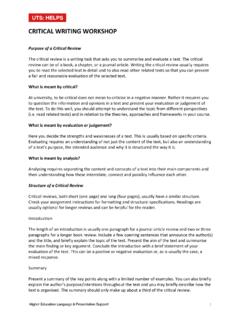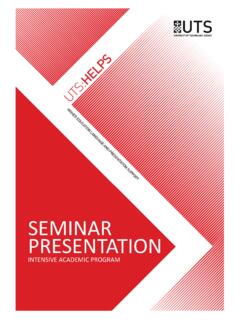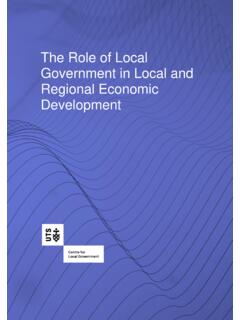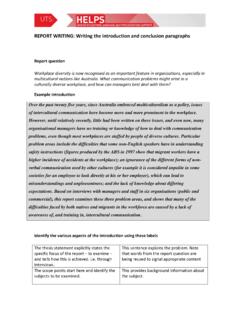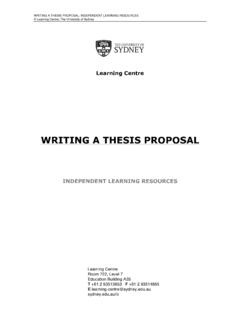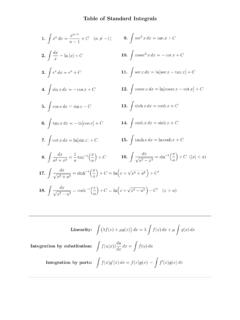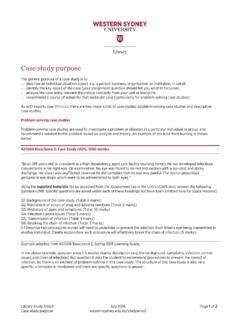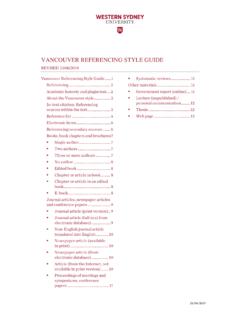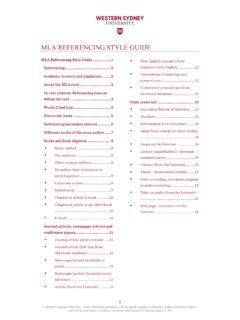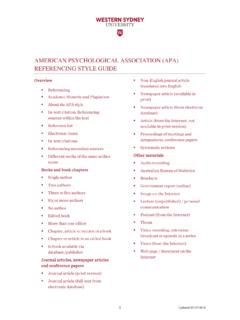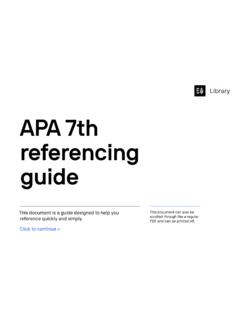Transcription of PRONUNCIATION - University of Technology Sydney
1 PRONUNCIATION . INTENSIVE ACADEMIC PROGRAM. Higher Education Language & Presentation Support (HELPS). University of Technology , Sydney Building 1, Level 5, Room 25. 15 Broadway, Ultimo NSW 2007. PO box 123 Broadway 2007 NSW Australia +61 2 9514 9733. UTS: HELPS / JULY 2016. Table of Contents Intensive PRONUNCIATION Program Overview ..1. Essential PRONUNCIATION Features ..2. Group Discussion ..3. The Sounds of English ..4. Making Consonant Sounds ..5. Consonant Clusters/Common Mistakes ..7. Making Vowel Sounds Practice ..10. Diagnostic Test 1 ..16. Your Ideas ..19. Sounds Past Tense Endings ..21. Stress ..21. Word Stress ..24. Stress Practice.
2 27. Frequently Used Academic Words ..30. Chunking and Pausing ..32. Chunking and Pausing in Chunking and Pausing Practice ..34. Sentence Stress ..36. Pausing and Focus Stress ..37. TED Presentation: extension activity ..38. Word and Focus Stress Stress for New Signpost Words Pausing and Stress ..43. Stress Practice ..45. Diagnostic Test 2 ..46. Practice Text 1 ..49. Practice Text 2 ..50. Practice Text 3 ..51. Practice Text 4 ..52. Practice Text 5 ..53. Connected Speech ..54. Intonation ..60. iii Useful How to Practise PRONUNCIATION ..68. Ways of Practising PRONUNCIATION ..70. PRONUNCIATION Checklist for Presenting ..72. iv Intensive PRONUNCIATION Program Overview Objectives: to develop an awareness of the important features of PRONUNCIATION to identify common problems for both individual and groups of students to practise listening for PRONUNCIATION features and incorporating them into dialogues, role plays and presentations to develop self-study PRONUNCIATION techniques with the use of a range of current audio-visual PRONUNCIATION resource materials.
3 Monday Tuesday Wednesday Thursday Friday Sounds Words Rhythm of Rhythm of Review Sentences Sentences Vowels Syllables Practice &. Pausing & Intonation Feedback Consonants Word Endings Chunking Connected Presentations Diphthongs Word Stress Sentence Stress Speech Resources &. Evaluation 1. Essential PRONUNCIATION Features 1. Sounds Consonants & Vowels 2. Speech chunks Chunking & Pausing 3. Stress Word stress & Sentence stress 4. Intonation Pitch level & Direction 5. Connected speech Unstressed words and Linking 6. Vocal features Speed, Volume, Projection . 7. Voice quality Warm, Abrupt, Confident . UTS/ELSSA Centre/ PRONUNCIATION Fact Sheet/ Stress/ HZ 09.
4 2. Group Discussion What is standard English? Does accent matter? Are all effective speakers of English native speakers? Which English accent do you prefer? English, American, Australian ? Do you want to totally lose your accent? What do you find most challenging abut English PRONUNCIATION ? How old were you when you started to learn English? Were you taught PRONUNCIATION ? Do you have a favourite English speaker? celebrity, politician, neighbour ? Do you think PRONUNCIATION is easy to teach? Why? What is your motivation for learning English? study; live and work in Australia;. use in business overseas; interest ? Watch the YouTube clip of Amy Walker introducing herself in 21 different accents: Which accents did you find difficult/easy?
5 Which did you like? 3. The Sounds of English 4. Making Consonant Sounds Some researchers believe seeing and feeling how a sound is formed physically will help you develop the ability to make that sound. Others think what you hear is more important. What do you think? 5. Go to following websites for help making English sounds: University of Iowa: ~acadtech/phonetics/ HELPS: resources/ PRONUNCIATION /sounds BBC/British Council: 6. Consonant Clusters/Common Mistakes Consonant clusters: Two or more consonants with no vowel between them. beginning of word pretty; street middle of word degree; entry; instrument end of word sift; asks Consonant clusters at the end of words can show grammatical meaning: plurals students; books past tense cooked; climbed present tense loves; thinks Common mistakes with consonants: use a different consonant light' sounds like night'.
6 Delete consonant at end of word save' sounds like say'. add a vowel past' sounds like pasta'. Common mistakes with consonant clusters: delete them first' sounds like fur'. delete some of them tense' sounds like ten'. add a vowel after or between consonants just' sounds like just a'; or improved'. sounds like improve it'. pronounce a different consonant fly' sounds like fry'. Adapted from Forman, R. 2011, Module 5: Phonemic Level', UTS Subject 013107, UTS, Sydney ; Yates, L. &. Zielinski, B. 2009, Give it a Go: Teaching PRONUNCIATION to Adults, Department of Immigration and Citizenship, Sydney . 7. Making Vowel Sounds Length The colon (:) following the phonemic symbol signals that the vowel is long (see Sounds of English).
7 It also depends on whether it is stressed short vowels may seem longer in a stressed syllable and long vowels may seem shorter in an unstressed syllable. Tongue position Horizontal (how far forward or back) and vertical (how high or low in mouth). 8. Diphthongs are a combination of two single vowels. We say them by starting with one vowel and gliding into another. Although they are made up of two vowels they are heard as one phoneme, not two. We put more emphasis on the first vowel than on the second. 9. Sounds Practice Hewings, M. 2004, PRONUNCIATION practice activities, Cambridge University Press, Cambridge. 10. 11. 12. 13. 14. 15. Diagnostic Test 1.
8 1. See you later. 2. Are you thirsty? 3. I have to go now. 4. What's that noise? 5. By tomorrow evening. 6. It's about five o'clock. 7. I sent a cheque to Roy. 8. It's on television today. 9. She's upstairs in the bath. 10. Peter works in a shoe shop. 11. Do you really want a drink? 12. I'll go to see Sarah before July. 13. Thanks a lot. 14. It's a pleasure. 15. I forgot to pay Mark for the toys. 16. Your jacket is on the chair outside. 17. Shall I do the washing? 18. Good idea. 19. We're usually home before the children. 20. There's a zoo near Hull. It's not far. 21. We bought an amazing orange and purple car. It's in the garage. 22. Can you just put the books over there by the door?
9 Hewings, M. 2004, PRONUNCIATION practice activities, Cambridge University Press, Cambridge. 16. 17. Hewings, M. 2004, PRONUNCIATION practice activities, Cambridge University Press, Cambridge. 18. Your Ideas Use these pages to make lists of vocabulary, phrases and sentences that you would like to practise this week. Examples: sounds, vocabulary, phrases or sentences from today vocabulary, phrases or sentences from your field of study phrases and sentences that you would like to use with more confidence socially, in class or at work phrases and sentences that may help you in a job interview, a class presentation or an exam sections of poetry you enjoy.
10 19. 20. Sounds Past Tense Endings 21. Stress Why is word stress important? Stress is one of the most important speech tools used by English speakers to communicate meaning. English speakers use stress to highlight information they think is important. In addition, every English word with more than one syllable or word part has a defined stress pattern. You can look up a dictionary to see which syllable is stressed. English stress is as important as English sounds. How does it work? The English stress system is based on the CONTRAST between stressed and unstressed syllables, stressed and unstressed words. Stressed syllables are longer and louder than unstressed syllables.
